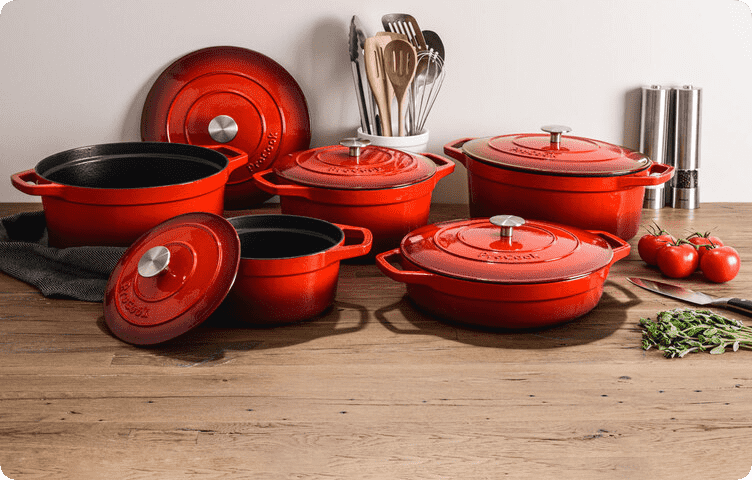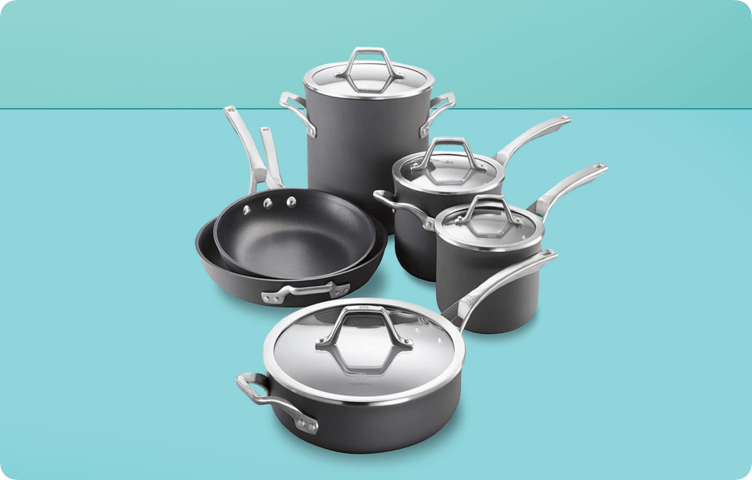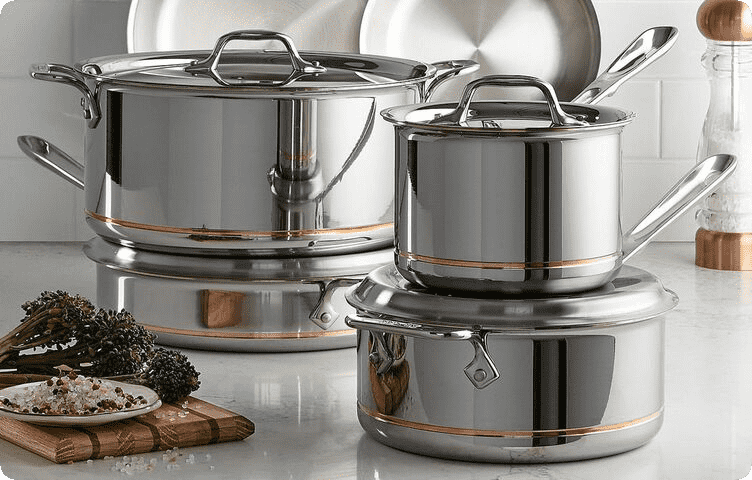Cook soup, stew meat, boil milk - all these operations are impossible without a good saucepan . What should it be: large or small, metal or glass? It is difficult for an inexperienced cook to find suitable utensils among the abundance that stores offer. First you need to understand the types and features of kitchen utensils.
What tasks does the pan solve?
Liquid dishes appeared in the human diet thousands of years ago, but for a long time they were prepared in clay pots. It was only in the 17th century that French chefs first began to use wide metal vessels with straight walls for cooking soups.
Since then, the pan has had many uses. In addition to soups, rice, dumplings and pasta are boiled in it, vegetables are stewed, and sauces are made.
Special varieties of this useful utensil are used for specific dishes. So, pilaf is cooked in a cauldron, cabbage rolls in a saucepan , and roast in a cast iron roasting pan .
Statistics show that a typical family of four regularly uses 6-7 pans. The restaurant requires at least 20 products of different sizes - from 2 to 50 liters.
Classification of containers by size
The size of the dishes is determined by four parameters: capacity, height, diameter of the bottom and top. The wider the bottom, the faster the dish cooks. Tall and narrow vessels are convenient for preparing sauces and broths.
Based on volume, pans are divided into three categories:
Small - holds 1-2 liters . Used for preparing porridges, gravies, boiling eggs;
Medium - designed for 3-5 liters . They prepare soup, boil pasta, potatoes and stew vegetables;
Large - have a volume of over 5 liters . They are used for cooking a significant amount of liquid products: compotes, fruit drinks, marinades.
It is recommended to have 4-5 products of different sizes at home.
Types of pans by materials

The utensils in which food is prepared daily should be durable, easy to use and not require difficult care. Modern manufacturers use more than a dozen materials, each of which has its own pros and cons.
Enameled
The enamel layer protects food from iron taste. Harmful bacteria do not linger on its surface. Modern enamel coatings can withstand changes in heat and cold, are easy to clean, and do not absorb foreign odors. But enamel requires careful handling - it is easy to scratch. Experts recommend using enamel pans for preparing children's dishes - soups, mashed potatoes.
Aluminum
Aluminum products attract cooks due to their strength and light weight. Due to their good thermal conductivity, they heat up quickly, speeding up the cooking process. But upon contact with acidic foods, the material loses its beautiful shine. During cooking you have to constantly watch, otherwise the food may burn. The most advantageous option is an aluminum pan with a protective coating of ceramic, titanium or stone chips.
Cast iron
The main advantage of cast iron utensils is their thick walls and bottom. This feature helps with stewing and simmering meat, vegetables, and cereals. The porous surface of cast iron is gradually saturated with oil, turning into a kind of non-stick coating.
Cast iron pans are not always easy to use due to their heavy weight. They may break due to a strong impact or fall.
Teflon coated
The utensil, protected by a layer of Teflon, is suitable for long-term stewing of meat and cooking pilaf. The coating reliably protects food from burning. But you need to handle it with care, since Teflon is easily damaged by metal tools.
Ceramic
Products made from durable natural material are heated evenly over the fire. Food in such a vessel does not burn and remains juicy and aromatic even after prolonged stewing.Ceramic saucepans can be placed not only on the stove, but also in the oven or microwave. They are easy to clean and do not require additional care.
The only negative is that if there is a sharp change in temperature, the product may crack. It is important to consider that sometimes manufacturers call ordinary aluminum utensils treated with a layer of silicone non-stick ceramics. This material is harmless, but over time it begins to peel off.
Glass
Tempered glass dishes are suitable for baking in the oven or microwave. Transparent material makes it possible to observe the cooking process. Glass saucepans are resistant to temperature changes and are easy to clean.
But the thermal conductivity of such utensils is worse than that of other materials, so the food is heated unevenly. There is no protective coating on the glass; food can burn.
Stainless steel
Pots made from this material are highly durable. They heat up quickly and do not come into contact with acids contained in food. The dishes can be put in the oven and washed in the dishwasher.
But stainless steel does not distribute heat as well as non-ferrous metals. To compensate for this deficiency, some manufacturers use aluminum or copper inserts.
From copper
Copper cookware conducts heat well, so the food in it heats up evenly. But the surface loses its shine when in contact with acidic foods. This may cause the dish to have a metallic taste. Copper products require careful care - periodically they need to be polished with vinegar and salt.
Types of pots by purpose

Professional chefs know more than 100 types of kitchen utensils for heat treatment. At home, no more than ten options are used, including:
Deep pan - has a cylindrical shape and a flat bottom. Equipped with two handles and a lid. This is a classic vessel for preparing liquid dishes, boiling flour products and vegetables;
A stewpan is a product that resembles a deep frying pan with a thickened bottom. Used for stewing, deep-frying, preparing thick sauces;
A pressure cooker is a device with a hermetically sealed lid that helps speed up the cooking process;
A Dutch oven is a large round container designed to simmer meats or stews in pots over low heat. Made from cast iron. For ease of use, it is equipped with two handles;
A cauldron is a deep vessel with a thick bottom. Used for preparing pilaf and national soups of oriental cuisine;
A gravy boat is a small saucepan with high walls and a long handle. Suitable for cooking soups, sauces, boiling eggs and heating food;
French Dutch oven - looks like a smaller version of a regular Dutch oven, enameled on the inside. Meat dishes, stews, and porridges are prepared in such dishes;
A cauldron is the name given to a large, tall pan for boiling or cooking over an open fire.
Many manufacturers create kitchen utensil sets that include 3-4 items for different purposes.
Selection rules

Before you go to the store for a new pan, decide what kind of dishes you are going to cook in it. Consider 5 more factors:
Material – dishes made of thinner material retain heat unevenly and are more likely to deform. Choose the most durable products with thick walls and bottom;
Thermal conductivity is the property of distributing heat and retaining it inside a container. In this regard, the leaders are utensils made of copper and aluminum, as well as pans with non-stick coating;
Convenience - check the reliability of the handles, the presence of a lid and the weight of the product. The heavy bottom provides good stability, but such dishes are difficult to move around the stove;
Coating – If you often prepare dishes containing tomatoes, lemon juice and other acidic foods, look for a product with a protective layer. Stainless steel and non-stick coatings do not react with acids;
Difficulty of care - find out whether the pan can be washed in the dishwasher, whether it requires adjustmentbright polishing.
When choosing, consider the price - high-quality dishes cannot cost less than 1000 rubles.
Care and storage rules
Good quality kitchen utensils will last a long time if you take proper care of them - wash them appropriately and protect them from damage. It is enough to follow only five rules:
- Do not place hot dishes in cold water as this may cause the bottom to warp.
- Fill the pan with hot, soapy water before washing.
- Wash non-stick coated products with soft sponges, avoiding abrasive cleaners.
- To remove burnt-on food, fill the container halfway with water and add a tablespoon of biological laundry detergent. Boil for 10 minutes, then rinse thoroughly.
- From time to time, lubricate cast iron cookware with vegetable oil to protect against rust. Clean copper and stainless steel utensils periodically with a special polish.
Pots are stored in kitchen cabinets, on shelves or vertical stands. To avoid damaging the inside of containers, line items with paper towels or pieces of felt. Store lids separately, such as on a plate drainer or separate shelf.
















































/https%3A%2F%2Fcomplexbar.com%2Fimages%2Fblog%2F132%2FPots1-2.png)
/https%3A%2F%2Fcomplexbar.com%2Fimages%2Fblog%2F246%2Fsirop_scale_2400.jpeg)
/https%3A%2F%2Fcomplexbar.com%2Fimages%2Fblog%2F246%2Fkofe-vostochniy.jpg)
/https%3A%2F%2Fcomplexbar.com%2Fimages%2Fblog%2F245%2Fpexels-jason-villanueva-851555.jpg)
/https%3A%2F%2Fcomplexbar.com%2Fimages%2Fblog%2F246%2F2024-04-09_17.22.54.jpg)
/https%3A%2F%2Fcomplexbar.com%2Fimages%2Fblog%2F246%2F2024-04-09_17.22.47.jpg)
/https%3A%2F%2Fcomplexbar.com%2Fimages%2Fblog%2F246%2FCODE_anons_foamydrops_752%D1%85480_eng.jpg)
/https%3A%2F%2Fcomplexbar.com%2Fimages%2Fblog%2F246%2FAlina_752%D1%85480_eng.jpg)
/https%3A%2F%2Fcomplexbar.com%2Fimages%2Fblog%2F246%2F2024-04-09_17.23.22.jpg)
/https%3A%2F%2Fcomplexbar.com%2Fimages%2Fblog%2F246%2F2024-04-09_17.23.28.jpg)
/https%3A%2F%2Fcomplexbar.com%2Fimages%2Fblog%2F246%2F2024-04-09_17.23.35.jpg)
/https%3A%2F%2Fcomplexbar.com%2Fimages%2Fblog%2F246%2Fdrinksome_752%D1%85480_eng.jpg)
/https%3A%2F%2Fcomplexbar.com%2Fimages%2Fblog%2F246%2Fnude_752%D1%85480_eng.jpg)
/https%3A%2F%2Fcomplexbar.com%2Fimages%2Fblog%2F246%2F752%D1%85480_eng__1_.jpg)
/https%3A%2F%2Fcomplexbar.com%2Fimages%2Fblog%2F246%2F752%D1%85480_eng.jpg)
/https%3A%2F%2Fcomplexbar.com%2Fimages%2Fblog%2F246%2FStudioRaw_752%D1%85480_eng.jpg)
/https%3A%2F%2Fcomplexbar.com%2Fimages%2Fblog%2F246%2FDoppio_tea_752%D1%85480_eng.jpg)
/https%3A%2F%2Fcomplexbar.com%2Fimages%2Fblog%2F246%2FTognana_Stars_Stripes_752%D1%85480_eng.jpg)
/https%3A%2F%2Fcomplexbar.com%2Fimages%2Fblog%2F246%2FRona_752%D1%85480_eng.jpg)
/https%3A%2F%2Fcomplexbar.com%2Fimages%2Fblog%2F246%2FDoppio_vending_752%D1%85480_eng.jpg)
/https%3A%2F%2Fcomplexbar.com%2Fimages%2Fblog%2F246%2FEssence_sukhie_smesi_752%D1%85480_eng.jpg)
/https%3A%2F%2Fcomplexbar.com%2Fimages%2Fblog%2F246%2FODK_sukhie_smesi752%D1%85480_eng.jpg)
/https%3A%2F%2Fcomplexbar.com%2Fimages%2Fblog%2F246%2Funiforma-barmena.jpg)
/https%3A%2F%2Fcomplexbar.com%2Fimages%2Fblog%2F246%2Fkak-nanyat-barmena.jpg)
/https%3A%2F%2Fcomplexbar.com%2Fimages%2Fblog%2F246%2Fsirop_scale_2400.jpeg)
/https%3A%2F%2Fcomplexbar.com%2Fimages%2Fblog%2F246%2FPeugeot_Anons_Paris_U%27Select_Line_Daman_752%D1%85480_eng.jpg)
/https%3A%2F%2Fcomplexbar.com%2Fimages%2Fblog%2F246%2Fkofe-vostochniy.jpg)
/https%3A%2F%2Fcomplexbar.com%2Fimages%2Fblog%2F246%2FMadler.jpg)
/https%3A%2F%2Fcomplexbar.com%2Fimages%2Fblog%2F246%2Fprofbartender_glavn.jpeg)